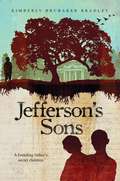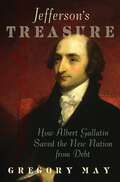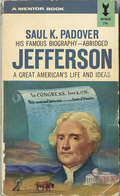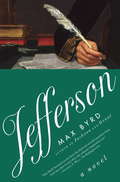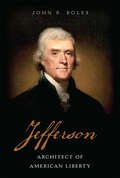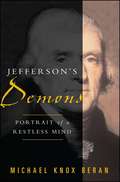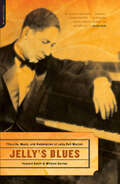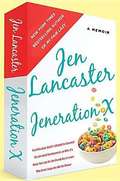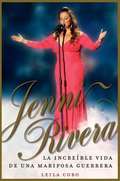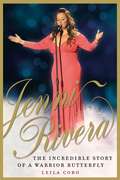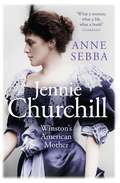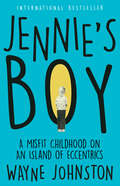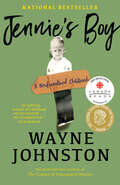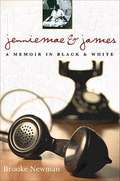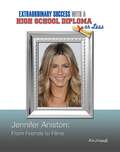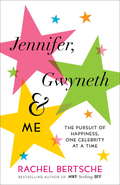- Table View
- List View
Jefferson's Sons
by Kimberly Brubaker BradleyThe untold story of Thomas Jefferson's slave children Beverly, Harriet, Madison, and Eston are Thomas Jefferson's children by one of his slaves, Sally Hemings, and while they do get special treatment--better work, better shoes, even violin lessons--they are still slaves, and are never to mention who their father is. The lighter-skinned children have been promised a chance to escape into white society, but what does this mean for the children who look more like their mother? As each child grows up, their questions about slavery and freedom become tougher, calling into question the real meaning of "life, liberty, and the pursuit of happiness." Told in three parts from the points of view of three of Jefferson's slaves--Beverly, Madison, and a third boy close to the Hemings family--these engaging and poignant voices shed light on what life was like as one of Jefferson's invisible offspring.
Jefferson's Treasure: How Albert Gallatin Saved the New Nation from Debt
by Gregory MayGeorge Washington had Alexander Hamilton. Thomas Jefferson had Albert Gallatin. From internationally known tax expert and former Supreme Court law clerk Gregory May comes this long overdue biography of the remarkable immigrant who launched the fiscal policies that shaped the early Republic and the future of American politics. Not Alexander Hamilton---Albert Gallatin. To this day, the fight over fiscal policy lies at the center of American politics. Jefferson's champion in that fight was Albert Gallatin---a Swiss immigrant who served as Treasury Secretary for twelve years because he was the only man in Jefferson's party who understood finance well enough to reform Alexander Hamilton's system. A look at Gallatin's work---repealing internal taxes, restraining government spending, and repaying public debt---puts our current federal fiscal problems in perspective. The Jefferson Administration's enduring achievement was to contain the federal government by restraining its fiscal power. This was Gallatin's work. It set the pattern for federal finance until the Civil War, and it created a culture of fiscal responsibility that survived well into the twentieth century.
Jefferson: A Great American's Life and Ideas
by Samuel K. PadoverThis famous biography has been in print for more than 40 years and stands as Jefferson's life story. It traces his life from his childhood as the son of a Virginia planter, to his years as a lawyer, to the Revolutionary War and the early years of the Union
Jefferson: A Novel
by Max ByrdAs he did with Presidents Jackson and Grant in those magnificent novels, Max Byrd now reveals Thomas Jefferson as we've never seen before. Byrd transports us to 1784, as Jefferson, the newly appointed American ambassador to the court of Louis XVI and Marie Antoinette, arrives in Paris--a city adrift in intrigue, upheaval, and temptation that will challenge his principles, incite his passions, and change him forever. Through the eyes of his impressionable young secretary, William Short, readers watch as the future president builds his dream of America with fellow patriots John Adams and Ben Franklin, while struggling between political ambition and an unexpected crisis of the heart with a woman who has the power to destroy him. Behind the face this complex Virginian shows the world, Thomas Jefferson is an enigmatic statesman who fights for individual liberty even as he keeps slaves, who champions free will even as he denies it to his daughters, and who holds men to the highest standards of honor--even as he embarks on a shadowy double life of his own. "Max Byrd's historical novels about the third and seventh presidents bring both men alive in ways that only a literary imagination can."--George F. Will, The Washington Post "Jefferson has the organic intimacy of a novel that has sprung full-blown from the imagination of its creator."--The New York Times "Superb . . . fascinating in the psychological insight it provides to one of the greatest Americans . . . a truly memorable book."--W. Jackson Bate, Pulitzer Prize-winning author of Samuel Johnson and John Keats "Absolutely splendid historical fiction that resonates with international, provincial, and individual passion and drama."--Booklist "A real tour de force."--San Francisco ChronicleFrom the Trade Paperback edition.
Jefferson: Architect Of American Liberty
by John B. BolesFrom an eminent scholar of the American South, the first full-scale biography of Thomas Jefferson since 1970As Alexander Hamilton's star has risen, Thomas Jefferson's has fallen, largely owing to their divergent views on race. Once seen as the most influential American champion of liberty and democracy, Jefferson is now remembered largely for his relationship with his slave Sally Hemmings, and for electing not to free her or most of the other people he owned.In this magisterial biography, the eminent scholar John B. Boles does not ignore the aspects of Jefferson that trouble us today, but strives to see him in full, and to understand him amid the sweeping upheaval of his times. We follow Jefferson from his early success as an abnormally precocious student and lawyer in colonial Virginia through his drafting of the Declaration of Independence at age 33, his travels in Europe on the eve of the French Revolution, his acidic personal battles with Hamilton, his triumphant ascent to the presidency in 1801, his prodigious efforts to found the University of Virginia, and beyond.From Jefferson's inspiring defenses of political and religious liberty to his heterodox abridgment of Christian belief, Boles explores Jefferson's expansive intellectual life, and the profound impact of his ideas on the world. Boles overturns conventional wisdom at every turn, arguing, among other things, that Jefferson did not--as later southerners would--deem the states rightfully superior to the federal government. Yet Boles's view is not limited to politics and public life; we also meet Jefferson the architect, scientist, bibliophile, and gourmet--as well as Jefferson the gentle father and widower, doting on his daughters and longing for escape from the rancorous world of politics.As this authoritative, evenhanded portrait shows, Jefferson challenges us more thoroughly than any other Founder; he was at once the most idealistic, contradictory, and quintessentially American of them all.
Jefferson’s Demons: Portrait of a Restless Mind
by Michael Knox Beran"I have often wondered for what good end the sensations of grief could be intended."-- Thomas Jefferson. Thomas Jefferson suffered during his life from periodic bouts of dejection and despair, shadowed intervals during which he was full of "gloomy forebodings" about what lay ahead. Not long before he composed the Declaration of Independence, the young Jefferson lay for six weeks in idleness and ill health at Monticello, paralyzed by a mysterious "malady."
Jeffrey Sachs
by Japhy WilsonAn investigation of Sachs's schizophrenic career, and the worldwide havoc he has caused. Jeffrey Sachs is a man with many faces. A celebrated economist and special advisor to UN Secretary-General Ban Ki-moon, he is also no stranger to the world of celebrity, accompanying Bono, Madonna and Angelina Jolie on high-profile trips to Africa. Once notorious as the progenitor of a brutal form of free market engineering called 'shock therapy', Sachs now positions himself as a voice of progressivism, condemning the '1 per cent' and promoting his solution to extreme poverty through the Millennium Villages Project. Appearances can be deceiving. Jeffrey Sachs: The Strange Case of Dr Shock and Mr Aid is the story of an evangelical development expert who poses as saviour of the Third World while opening vulnerable nations to economic exploitation. Based on documentary research and on-the-ground investigation, Jeffrey Sachs exposes Mr Aid as no more than a new, more human face of Dr Shock. From the Trade Paperback edition.ing himself as an evangelical development expert and savior of the Third World, while actually working to reinforce the neoliberal project that he now claims to oppose. Based on documentary research and on-the-ground investigation of the Millennium Villages Project, Jeffrey Sachs exposes its subject's Jekyll/Hyde complex, showing Mr. Aid to be no more than the new, more human face of Dr. Shock himself. From the Trade Paperback edition.
Jella Lepman and Her Library of Dreams: The Woman Who Rescued a Generation of Children and Founded the World’s Largest Children’s Library
by Katherine PetersonThe inspiring true story of how one visionary woman used children’s books to help heal a generation of Germany’s children after WWII and went on to set up the International Youth Library and International Board on Books for Young People (IBBY). Written by Katherine Paterson, the beloved and award-winning author of Bridge to Terabithia and many other children’s favorites.Jella Lepman was a woman who stood her ground, challenged convention, and worked fiercely to transform her biggest dreams into reality.In 1945, when Jella was tasked with what seemed like an insurmountable challenge―to create a haven of imagination and joy for the children of a Germany scarred by war—she turned to a steadfast companion: books. As a Jewish woman who had fled from the Nazis, Jella was determined to restore a sense of childhood to the young people who had only known conflict and violence. Despite constant obstacles, Jella persevered, and with the help of publishers and children from around the world, she amassed an extraordinary collection of 4,000 children’s books in pursuit of her mission to promote peace. The roving literary collection would eventually find a home as the International Youth Library in Munich, now with over 600,000 items, the largest collection of children’s books and materials in the world.Jella Lepman and Her Library of Dreams is a thrilling and heartfelt exploration of one woman’s extraordinary belief in the power of books to transform young lives. Perfect for readers who enjoy illustrated biography, true adventure nonfiction, and empowering stories of women in history, this makes an outstanding addition to classroom and home libraries.WORLD HISTORY FOR KIDS: This book reflects on the aftermath of WWII and its effect on children in Germany. By Jella Lepman’s inspiring example, readers will learn how working together and being part of a community can help bring peace after war, displacement, and loss.FASCINATING TRUE STORY: This picture book biography introduces a little-known historical figure who changed the world through children’s books. Anyone who loves history, biographies, or children’s literature will find themselves inspired by the life and work of Jella Lepman.IMPORTANCE OF BOOKS & LIBRARIES: Featuring inspiring illustrations of global cooperation, crates of international books being shipped to the library, and children in the harshest of conditions finding solace in reading, this book is perfect for celebrating librarians and their positive impact on young lives. It also highlights the ongoing work of the International Board on Books for Young People (IBBY), a non-profit organization that represents an international network of people who are committed to bringing books and children together.Perfect for:Librarians, educators, and parents seeking engaging history and nonfiction books for kidsFans of true stories, biographies, and fascinating factsAnyone interested in learning about children’s literature and children's book librariesSpecial occasion or thank you gift for teachers and librariansFans of Katherine Paterson and her award-winning books, including Bridge to Terabithia, Jacob Have I Loved, and The Great Gilly Hopkins
Jelly Roll Blues: Censored Songs and Hidden Histories
by Elijah WaldA bestselling music historian follows Jelly Roll Morton on a journey through the hidden worlds and forbidden songs of early blues and jazz. In Jelly Roll Blues: Censored Songs and Hidden Histories, Elijah Wald takes readers on a journey into the hidden and censored world of early blues and jazz, guided by the legendary New Orleans pianist Jelly Roll Morton. Morton became nationally famous as a composer and bandleader in the 1920s, but got his start twenty years earlier, entertaining customers in the city&’s famous bordellos and singing rough blues in Gulf Coast honky-tonks. He recorded an oral history of that time in 1938, but the most distinctive songs were hidden away for over fifty years, because the language and themes were as wild and raunchy as anything in gangsta rap. Those songs inspired Wald to explore how much other history had been locked away and censored, and this book is the result of that quest. Full of previously unpublished lyrics and stories, it paints a new and surprising picture of the dawn of American popular music, when jazz and blues were still the private, after-hours music of the Black "sporting world." It gives new insight into familiar figures like Buddy Bolden and Louis Armstrong, and introduces forgotten characters like Ready Money, the New Orleans sex worker and pickpocket who ended up owning one of the largest Black hotels on the West Coast. Revelatory and fascinating, these songs and stories provide an alternate view of Black culture at the turn of the twentieth century, when a new generation was shaping lives their parents could not have imagined and art that transformed popular culture around the world—the birth of a joyous, angry, desperate, loving, and ferociously funny tradition that resurfaced in hip-hop and continues to inspire young artists in a new millennium.
Jelly's Blues: The Life, Music, and Redemption of Jelly Roll Morton
by Howard Reich William GainesJelly's Blues recounts the tumultuous life of Jelly Roll Morton (ca., 18851941). A virtuoso pianist with a larger-than-life personality, he composed such influential early jazz pieces as "King Porter Stomp" and "New Orleans Blues." However, by the late 1930s, he was nearly forgotten. In 1992, the death of an eccentric memorabilia collector led to the unearthing of a startling archive, revealing Morton to be a much more complex and passionate man than many realized. An especially immediate and visceral look into the jazz worlds of New Orleans and Chicago, Jelly's Blues is a definitive biography, a long overdue look at one of the twentieth century's most important composers.
Jeneration X
by Jen LancasterIn Such a Pretty Fat, Jen Lancaster learned how to come to terms with her body. In My Fair Lazy, she expanded her mind. Now the New York Times bestselling author gives herself—and her generation—a kick in the X, by facing her greatest challenge to date: acting her age. Jen is finally ready to put away childish things (except her Barbie Styling Head, of course) and embrace the investment-making, mortgage-carrying, life-insurance-having adult she’s become. From getting a mammogram to volunteering at a halfway house, she tackles the grown-up activities she’s resisted for years, and with each rite of passage she completes, she’ll uncover a valuable—and probably humiliating—life lesson that will ease her path to full-fledged, if reluctant, adulthood. .
Jenni Rivera (Spanish Edition)
by Leila CoboComo una estrella resplandeciente y fugaz, Jenni Rivera iluminó la vida de millones de personas, pero el cielo se la llevó antes de tiempo. Jenni Rivera: La increíble vida de una Mariposa Guerrera: Fotos a todo color La discografía de Jenni Rivera Lista Billboard de los ranking de las canciones de Jenni Entrevistas exclusivas Una biografía completa, entretenida y objetiva Escrita por una de las líderes de opinión de la música latina Jenni fue la artista latina más vendida dentro del género regional mexicano. Con un programa de radio semanal, su propio programa de telerrealidad, una línea de maquillaje y ropa y su propia fundación, estaba en la cima de su carrera y de su vida. Todo lo que había logrado con sangre, sudor, lágrimas y alegría iba, según ella misma decía, de la mano de Dios. Pero su vida, sus sueños y la alegría que le regalaba a millones, llegaron a un trágico final la madrugada del 9 de diciembre de 2012. En Jenni Rivera: La increíble vida de una Mariposa Guerrera, Leila Cobo --pianista, presentadora de televisión y directora ejecutiva del contenido y la programación latina de Billboard-- nos regala una biografía íntima y conmovedora sobre Jenni Rivera, la parrandera, la elegante, la gran diva, la amiga, la mamá y la abuela. Descubrirás los comienzos de la vida y la carrera de Jenni y los momentos emocionantes y a veces turbulentos que conformaron su persona y su espíritu. Como una luz que se apaga antes de tiempo, con la partida de Jenni no solo perdimos a la inolvidable, la reina de reinas, la mariposa guerrera, sino que se fue también una mujer valiente que no temía enfrentar los altibajos de la vida en busca de la felicidad. Jenni nos dejó un ejemplo de vida, que resonará por siempre en cada nota de su voz.
Jenni Rivera: The Incredible Story of a Warrior Butterfly
by Leila CoboLIKE A BLAZING SHOOTING STAR, JENNI RIVERA LIT UP THE LIVES OF MILLIONS OF PEOPLE, YET THE SKY SWEPT HER AWAY BEFORE HER TIME Jenni Rivera: The Incredible Life of a Warrior Butterfly: Full color photos The complete discography of Jenni Rivera Billboard lists of sales rankings of Jenni's songs Exclusive interviews A complete, entertaining, and objective biography Written by one of the country’s leading experts in Latin music Jenni Rivera was the top-selling artist within the Regional Mexican music genre. With a weekly radio show, her own reality show, a makeup and clothing line, and her own foundation, she was at the height of her career and life. Everything she had conquered, with blood, sweat, tears, and smiles, hap¬pened, as she said, with God leading her by the hand. However her life, her dreams, and the joy she shared with so many came to a tragic end just before dawn on December 9, 2012. In Jenni Rivera: The Incredible Story of a Warrior Butterfly, Leila Cobo-pianist, TV host, and Executive Director for Latino content and programming at Billboard-brings us Jenni Rivera’s intimate and moving biography, reflecting on the party girl, the elegant woman, the great diva, the friend, the mother, and the grandmother. Discover the humble beginnings of Jenni’s life and career, as well as the emotional and sometimes turbulent moments that defined her persona and spirit. Like a candle blown out before her time, we not only lost the "Unforgettable One,” the "Queen of Queens,” the "Warrior Butterfly,” we also lost a brave woman who fearlessly faced life’s ups and downs to attain the happiness she so fervently wanted for herself and her family. With Jenni’s departure, we celebrate a shining legacy that will forever reverberate within every note of her voice. .
Jennie Churchill: Winston's American Mother
by Anne SebbaJennie Churchill was said to have had two hundred lovers, three of whom she married. But her love for her son Winston never wavered. Jennie Churchill is an intimate picture of her glittering but ultimately tragic life, and the powerful mutual infatuation between her and her son. Anyone who wants to understand Winston must start here, with this revelatory interpretation. Anne Sebba has gained unprecedented access to private family correspondence, newly discovered archival material and interviews with Jennie's two surviving granddaughters. She draws a vivid and frank portrait of her subject, repositioning Jennie as a woman who refused to be cowed by her era's customary repression of women.
Jennie Finch: Softball Superstar
by Christine Dzidrums Leah Rendon Joseph DzidrumsJennie Finch fell in love with baseball as a four-year-old when her mother took her to Dodger games. A year later, her parents signed her up for softball lessons and the young girl was instantly smitten. As a youngster, Jennie dominated travel softball and later became a star player at La Mirada High School in Southern California. During her time at University of Arizona, she set an NCAA record with 60 consecutive wins. Blessed with remarkable pitching ability, good looks and role-model sportsmanship, Jennie became a breakout celebrity at the 2004 Athens Olympics, where she captured gold with Team USA. A children's biography, Jennie Finch: Softball Superstar details the California native's journey as she transitioned from a shy youngster playing in a t-ball league to become softball's most famous face, a devoted mother of three and a legend in women's sports.
Jennie's Boy: A Misfit Childhood on an Island of Eccentrics
by Wayne JohnstonThe sad, tender, and extremely funny memoir of a boyhood few thought he would survive, including the unforgettable mother and hilarious grandmother who raised himA book to be relished by lovers of such works as The Glass Castle, Don't Let's Go to the Dogs Tonight, and Angela's AshesEverything readers love about consummate storyteller and beloved bestselling novelist Wayne Johnston's work is on full display in Jennie&’s Boy: incredible characters, brilliant language, and a deep sense of place.Wayne Johnston&’s family — his mother, father, and three brothers — were always on the move. The year he turned eight, the most memorable year of an unusual childhood, they found themselves occupying a wreck of a house in the community his mother Jennie was from: Goulds, Newfoundland was not so much a place as a scattering of homes along an unpaved road.Everyone knew him as &“Jennie&’s boy,&” and his tiny, ferocious mother felt judged for Wayne&’s sickly, skinny condition — he had to spend much of his time in a bed on wheels that was moved from room to room. While his brothers went off to school, Wayne passed his days with his witty, eccentric maternal grandmother, Lucy, whose son Leonard had died at the age of seven and whose photo stood alongside a statue of the Blessed Virgin. Jennie's Boy recalls a boyhood full of pain, laughter, tenderness, and the kind of wit for which Newfoundlanders are known. By that wit, and by their love for each other — so often expressed in the most unloving ways — he, and they, survived.
Jennie's Boy: A Newfoundland Childhood
by Wayne JohnstonNATIONAL BESTSELLERNAMED A BEST BOOK OF THE YEAR BY THE CBCWINNER OF THE 2023 LEACOCK MEDAL FOR HUMOURConsummate storyteller and bestselling novelist Wayne Johnston reaches back into his past to bring us a sad, tender and at times extremely funny memoir of his Newfoundland boyhood.For six months between 1966 and 1967, Wayne Johnston and his family lived in a wreck of a house across from his grandparents in Goulds, Newfoundland. At seven, Wayne was sickly and skinny, unable to keep food down, plagued with insomnia and a relentless cough that no doctor could diagnose, though they had already removed his tonsils, adenoids and appendix. To the neighbours, he was known as &“Jennie&’s boy,&” a backhanded salute to his tiny, ferocious mother, who felt judged for Wayne&’s condition at the same time as worried he might never grow up.Unable to go to school, Wayne spent his days with his witty, religious, deeply eccentric maternal grandmother, Lucy. During these six months of Wayne&’s childhood, he and Lucy faced two life-or-death crises, and only one of them lived to tell the tale.Jennie&’s Boy is Wayne&’s tribute to a family and a community that were simultaneously fiercely protective of him and fed up with having to make allowances for him. His boyhood was full of pain, yes, but also tenderness and Newfoundland wit. By that wit, and through love—often expressed in the most unloving ways—Wayne survived.
Jennie: The Life of Lady Randolph Churchill
by Ralph G. Martin(Volume II, The Dramatic Years 1895-1921)
Jennie: The Romantic Years 1854-1895
by Ralph G. MartinHaving spent 30 weeks on the New York Times bestseller list, Ralph Martin's Jennie: The Life of Lady Randolph Churchill is the story of a girl from Brooklyn who became the toast of British society.
Jenniemae & James: A Memoir in Black & White
by Brooke NewmanJames Newman was a brilliant mathematician, the man who introduced the mathematical concept “googol” and “googolplex” (aka “google” and “googleplex”) to the world, and a friend of Einstein’s. He was also a notorious philanderer with an insatiable appetite for women and fast cars, a man who challenged intellectual and emotional limits, and a man of excess who oftentimes fell victim to his own anxiety. Jenniemae Harrington was an uneducated, illiterate African American maid from Alabama who began working for the Newman family in 1948-and who, despite her devout Christianity, played the illegal, underground lottery called “policy,” which she won with astonishing frequency. Though highly implausible, these two dissimilar individuals developed a deep and loyal friendship, largely because of their common love of numbers and their quick wits. Theirs was a friendship that endured even during an era when segregation still prevailed. For James, Jenniemae provided a particular ease and shared sense of irreverent humor that he found difficult to duplicate with his beautiful, intelligent, and artistic wife, Ruth. And when the Newman home was darkened by the tensions of the political climate during the Cold War, or by James’s affairs, or by Ruth’s bouts of depression, it was Jenniemae who maintained the point of gravity, caring for the family’s children when their parents were often lost in their own worlds. From Jenniemae’s perspective, James offered more than just a steady income. He became an unlikely and loyal friend. He taught her to read, and he drove her to and from his upscale suburban house and her home in the impoverished section of Washington, D. C. (and sometimes, much to her chagrin, in his Rolls-Royce), after she had been raped by a white bus driver. Intrigued by her uncanny wins at the lottery, James even installed a second telephone line in the house so that Jenniemae could keep track of her bets-a decision that raised a few eyebrows at the time. It is this extraordinary relationship that the Newmans’ daughter, Brooke, reveals inJenniemae & James, as she elegantly weaves together the story of two very distinct and different people who each had a significant impact on her upbringing. In doing so, she also paints a vivid political and cultural picture of the time-when the world was terrified by the possibility of nuclear war; when America was reeling from the McCarthy hearings; when technological advances like televisions, satellites, and interstate highways were changing the country; when America was just beginning to venture into Vietnam; and when African Americans were still considered second-class citizens with limited rights, before the explosion of racial tensions in the early 1960s. Jenniemae & Jamesis an inspiring, heartwarming memoir about friendship and love across the racial barrier.
Jennifer Aniston: From Friends to Films (Extraordinary Success with a High School)
by Kim EtingoffIn the last few decades, more and more people are going to college to further their education. It's hard to become a scientist, a professor, or a businessperson without getting some sort of college degree--but college isn't always necessary to achieve success. Some people are ready to enter the workforce right after high school. Jennifer Aniston was one of these people. The world-famous actress has starred in television shows and movies, both big Hollywood hits and independent films. Since her breakout role on "Friends", Jennifer's been hugely successful in the world of acting. Few stars are as well known around the world as Jennifer Aniston. And what's most amazing about Jennifer's story is that the actress reached her goals without a college degree!
Jennifer Capriati
by Mikki MorrissetteDescribes the fifteen-year-old tennis player, who has rocketed up the world tennis rankings in only two years of professional playing.
Jennifer Lopez: An Unauthorized Biography
by Patricia J. DuncanRead the whole story behind the strong and sassy girl who from the Bronx transformed herself into one of Hollywood's leading divas!Moviegoers know her as George Clooney's gorgeous co-star in Out of Sight, Wesley Snipes' super-sexy love interest in Money Train, and the captivating star of Selena. Now this detailed bio explores the Jennifer Lopez few know-from her childhood in the Bronx in a close-knit Puerto Rican family, to her big break into films, to her groundbreaking status as the highest-paid Latina actress in Hollywood.This fast-track account traces every step of Jennifer's journey to the top, through hard work, clean living, fearless ambition, and home-grown pride. L'Oreal model, burgeoning recording artist, and mega-talented actress with a smashing lineup of new movies in the works, Jennifer Lopez is a force to be reckoned with.Bilingual edition.
Jennifer's Way: My Journey with Celiac Disease--What Doctors Don't Tell You and How You Can Learn to Live Again
by Jennifer EspositoAward-winning actress Jennifer Esposito tells a riveting personal story about her own journey and experience with chronic illness, and her long-awaited diagnosis: celiac disease. Armed with this knowledge, she vowed to rebuild her life to ensure her wellness, and she learned how to live again. The National Foundation for Celiac Awareness estimates that as many as 1 in 133 Americans has celiac disease, and 83% of people who have it are undiagnosed or misdiagnosed with other conditions. Jennifer received an accurate diagnosis only after decades of mysterious illnesses and misdiagnoses. Upon being diagnosed with celiac disease, she dedicated herself to advocacy through her nonprofit foundation for celiac education, Jennifer's Way. She also owns and operates a gluten-free bakery called Jennifer's Way in Manhattan. Jennifer, who starred in the Oscar-winning film Crash and CBS's Blue Bloods, will not let her diagnosis deter her--or anyone else--from living a successful and healthy life. She provides hope for all those who suffer. For anyone struggling with a chronic illness, Jennifer's Way is proof that there is a solution for what ails you, that you shouldn't stop until you find it, and that you can feel good again.
Jennifer, Gwyneth & Me
by Rachel BertscheFor fans of The Happiness Project and The Year of Living Biblically comes a pointed look at our fascination with celebrities, as one woman strives to remake herself in the image of her favorite stars. What woman hasn't seen pictures of Jennifer Aniston, Gwyneth Paltrow, or Beyoncé and wished she had their clothes, their abs, their seemingly flawless lives? For Rachel Bertsche, these celebrities are the epitome of perfection--self-assured and effortlessly cool. Yet lately, between juggling her career, her marriage, and her dream of becoming a mother, Bertsche feels anything but put together. In Jennifer, Gwyneth & Me, Bertsche embarks on a quest to emulate her Hollywood role models--while sticking to a budget--to see if they really hold the keys to happiness. While trying to unlock the stars' secrets, from Sarah Jessica Parker's wardrobe to Julia Roberts's sense of calm to--maybe one day--Jessica Alba's chic pregnancy, Bertsche learns valuable lessons. A toned body doesn't come easy or cheap, avoiding social media can do wonders for your peace of mind, and confidence is the key to pulling off any outfit. But can she immerse herself in the A-list lifestyle and still stay true to herself? And will her pursuit of perfection really lead to happiness?
